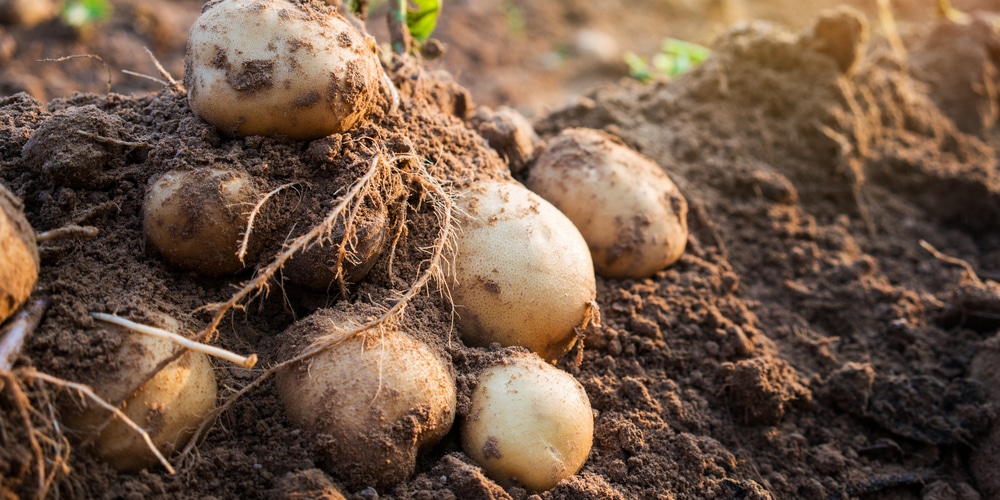Growing crops in your garden is not only a way to spend some time outdoors. It also provides you with a constant supply of delicious vegetables (or fruits) and can give you plenty of satisfaction. But let’s not hide the truth: things can be frustrating when things don’t go how you expect them to.
And problems may occur, even with relatively easy-to-care-for plants. After all, we are all humans! For instance, have you ever wondered why your potatoes are falling over? If you are growing these tubers, you’ll notice it is not so uncommon. But what can you do about this? And does that mean you won’t get harvests at the end of the season?
Keep reading this essential guide to clarify all of the doubts you might have on the matter.
Why Do Potatoes Fall Over?
Naturally, potatoes will fall over when the tubers are ready for harvest. So, with mature plants, this shouldn’t be a concern. At the end of the potato plant’s life cycle, its leaves and shoots will turn yellow.
So, you won’t have issues identifying that. And usually, that happens about 75 to 100 days from sowing potato seeds in your garden, so if you are in doubt, you can make some calculations.
However, overfertilization, warm temperature, inadequate watering, and diseases might cause your plants to fall before they mature. Under such circumstances (if you don’t take measures to revert the situation), your crops might fail to produce. But let’s look deeper into what you can do to grow healthy potatoes in your garden.
Leggy Potato Plants
One of the most common reasons for a potato plant falling is when it grows too tall. That generally happens when you feed your crops with products with too much nitrogen. Indeed, despite being crucial to a plant’s healthy growth, too much of this element will encourage foliage growth at the expense of fruits.
Pruning isn’t necessarily what will help here. Instead, you can solve the issue by providing adequate support to your plants. Like you would do when growing tomatoes, staking your potato plants prevents falling over and minimizes the risk of fungal infections and attacks from pests (due to the close contact with the soil).
Alternatively, you can also hill your plants. The technique refers to adding layers of soil at the base of your plant to protect the tubers from excessive light exposure and provide the plant with proper support.
But to prevent your plants from growing leggy, you must pay attention to their needs. Ensure you plant them in a sunny location and water them when they need moisture!
Inappropriate Growing Conditions
Potatoes are versatile crops. However, they won’t do well in extreme temperatures, under which the plant will suffer and fail to produce potatoes. Too much heat will cause potatoes to fall over and wilt. And this usually happens when the soil temperatures go above 80°F.
Gardeners that grow their crops in containers might have more issues with this. Additionally, sowing your seeds too late in the season might expose them to extreme temperatures. For this reason, you should always check your local weather before planning to plant your seeds.
Also, don’t forget that frost will kill your potatoes and eventually cause them to fall over. So, make sure you protect your plants from extreme environmental conditions. You can use row covers to shield your tubers from the cold, wind, and pests.
Inadequate Watering
As with most plants, too little or too much watering is a common source of problems when growing potatoes. Overwatering might cause root rotting resulting in the plant falling over due to the lack of nutrients. Indeed, when the ground gets waterlogged (and paradoxically as it sounds), a plant loses its ability to absorb moisture and nutrition from the soil.
Look for early indications of the issue to take measures to revert the conditions. Usually, a potato plant’s leaves will curl when the plant receives too much moisture. Also, feel the soil with your fingers before adding extra water: it must be dry to a depth of a few inches. Avoid wetting the leaves as it might make your plant more susceptible to diseases and fungal infections.
Diseases
Some diseases might cause potato falls. Early blight and late blight are some of the most common. They usually appear in moist soils, and one of the first symptoms includes brown spots on the leaves.
If one of the two attacks your potatoes, you will be better off removing the infected plants to prevent the disease from spreading to other areas of your garden.

